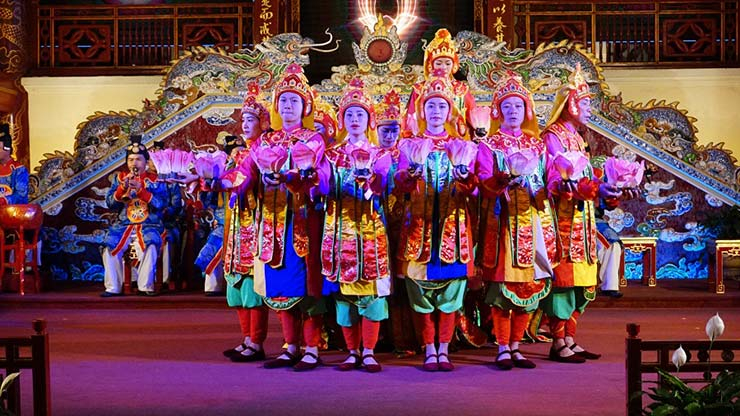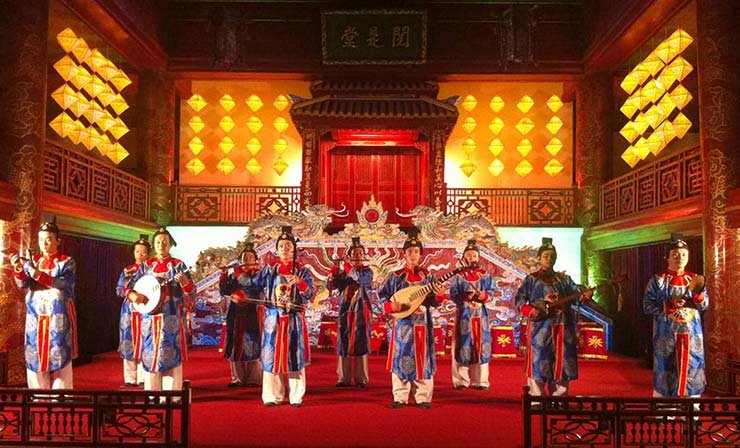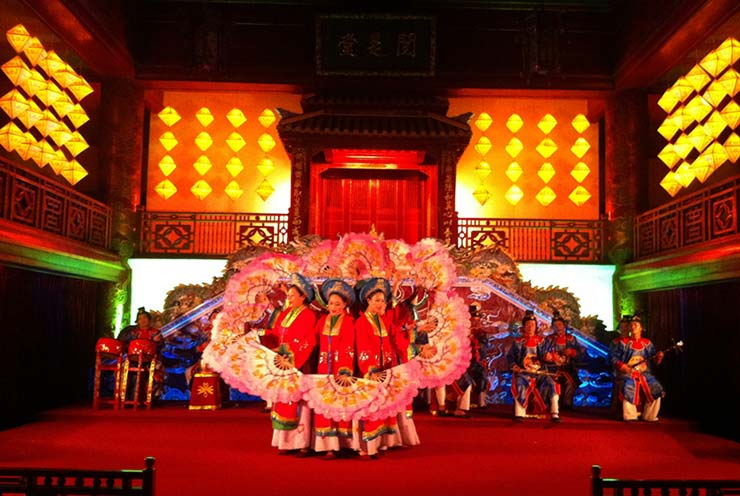Landed in Hue in August, the former capital of Vietnam welcomed us with a light rain and a smell of what my friend calls “a very smell of Hue”. Far different from the hustle, bustle of Ha Noi, streets of Hue possess tranquillity with rarely honking sounds of vehicles. Perfume River drifts away our stresses and messiness of “bringing the bread home”.
People first time to Hue will feel exciting and somewhere find a silence in this city, passing by all the spots can be easily named: the Imperial Citadel back to the Nguyen dynasty; Ancient Emperors’ Tombs; Huyen Tran Princess Temple; Perfume River; Thien Mu Pagoda; Hue Museum of Royal Antiquities;... However, all this royal fanciness seems like blurring an extravaganza art, called Nha Nhac - Vietnamese royal court music, which credits to the masterpiece of Hue in particular, and Vietnam in general.
“Nha Nhac” (Vietnamese royal court music), which has been recognised by the UNESCO as world cultural heritage, is a special art form of the Imperial City of Hue, the central province of Thua Thien-Hue.

UNESCO defines Nha Nhac as the “elegant music”, a broad range of musical and dance styles performed at the Vietnamese royal court from the fifteenth to the mid-twentieth century. This elegant music is often featured at the opening and closing of ceremonies associated with anniversaries, religious holidays, coronations, funerals and official receptions. At the present time, the music is performed in many countries in the world as a tribute to Vietnamese culture.
Nha Nhac is considered as the only national music of the country among several Vietnamese genres of music. During the feudal period, the royal court music was played as symbolises the king's longevity and prosperity of the dynasty. Therefore, “Nha Nhac” was highly valued by Vietnamese monarchies. Under the Nguyen Dynasty, Nha Nhac was performed during important ceremonies of the Royal Family.

As a priceless treasure of Vietnam, Nha Nhac has its own court orchestra with the presentation of the most valuable musical instruments of Vietnam such as wind instruments, strings instruments, membranophones, among others, associated with rich rhythms and songs with profound content. Nha Nhac performances also featured numerous singers, dancers and musicians dressed in sumptuous costumes.
A court music will come in three forms of Dai Nhac, Tieu Nhac (including orchestras and pieces mainly preserved at folk festivities), and court dances.
Each performance is a unique and creative story that reflects life, hope and dream of people back then. Any performance requires all performers to maintain a high level of concentration and follow each step of the ritual meticulously.
Fan dance is often performed for the Nguyen's Queen, Concubine, and Princess in banquets, wedding parties. The dance praises love life, blessing for the harmony and happiness of the family.

Other performances such as "Huu bien vo hinh" - Ghost hunting, the play is about the time when the world is filled with monsters, destroying and harming human kind, disregarding morality; 'Lantern Dance' - or 'Luc cung hoa dang' is a dance used in Buddhist rituals, containing six times of worship, expressed through six dances, each time offering a sacrificial such as: incense, flowers, lantern, tea, fruit, food. Later on used as the performance to celebrate the Emperor and royalties' birthdays.
We felt honoured to enjoy Nha Nhac in Duyet Thi Duong, located inside the Imperial Citadel. This is the first theatre opened to perform Royal music that was built during the Nguyen Dynasty, nearly 200 years ago. This is also one of the oldest performance spaces in Vietnam and a place to perform many art genres such as opera, dance, and court music for the king's inner palace. We were truly impressed with the majestic, solemn space and sacred atmosphere.
Visitors to Hue can also enjoy this type of scholarly music on one of the Perfume River Boat Rides. It is worthy to enjoy as a way to learn and explore the wealth of heritage of Vietnam.




